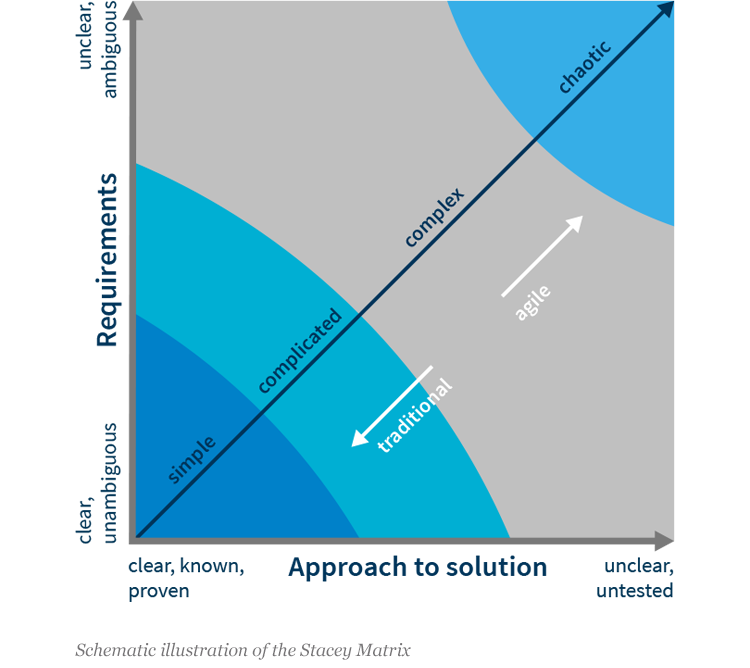Classic, agile or hybrid project management – what do I choose in a project? The Stacey Matrix (after the organizational theorist Ralph D. Stacey) can provide a decision support. A criteria catalog is used to assess how well a project plan is already understood – in terms of requirements on the one hand and the solution approach on the other. Are the requirements clear or are we moving into a new, as yet unknown market? Are you using a well mastered technology or a new one with which you have no experience?

Simple, complicated, chaotic?
Along these two axes, the Stacey matrix divides a project into the categories simple, complicated, complex and chaotic. According to the so-called Cynefin framework, simple systems are ordered so clearly that they can be understood immediately. Complicated systems are difficult to understand. With expert knowledge, however, it is possible to understand and predict their cause-effect relationships in advance.
Although complex systems are also determined by clear causalities, they exhibit so many interactions that even experts are no longer able to analyze them sufficiently in advance. The correlations can only be recognized and understood afterwards. A system is described as chaotic if there are no clear causal relationships and one and the same cause can produce completely different effects.
A small example illustrates this:
For a meteorologist, for example, a weather forecast for the next hour may be simple, one for the next day complicated. A forecast for the next week, on the other hand, might be a complex problem, while the forecast for one day of the next year is certainly a chaotic one.
As long as project plans are simple or complicated, they can be well mastered with a waterfall like, firmly predefined procedure depending on the expertise. However, the more they tend towards complexity, the more an agile, flexible approach with many feedback loops and the possibility of trial and error is recommended. I think this is a plausible approach, which, by the way, can be applied not only to entire projects, but also selectively to individual areas in a project.
The social dimension
But perhaps this approach is not quite enough. We have talked about requirements and about approaches to solutions, but not yet about the people who work together in the project. Isn’t their organizational and social interaction also simple, complicated or complex to chaotic? And doesn’t this factor have the same major impact on the success of the project? In my opinion, this is precisely the point at which one must speak of unpredictability, i.e. complexity.
A well-rehearsed team that has been working together for years can certainly be classified as easy. However, it is often forgotten that hardly predictable dynamics can occur in a newly assembled team or in a new cooperation of different departments with different interests. Here, agile methods with their focus on results-oriented communication can be the key to mastering the project.
So perhaps we should add a third dimension, “social interaction”, to the two axes “requirements” and “solution approach” in order to complete the decision model and lay the foundation for project success.

